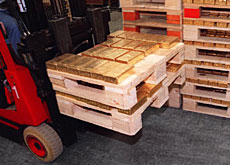Pension scheme to benefit from excess gold

Parliament has taken a first step towards agreeing to spend most of the proceeds from the sale of the Swiss National Bank’s excess gold reserves on the state pension scheme.
Previous plans, including a proposal to spend the proceeds on humanitarian projects, were rejected by Swiss voters two years ago.
If the plans are approved by the Senate, the money from the sale of 1,300 tons of excess gold will be kept in a special fund and lead to annual interest payments of SFr450 million ($364 million).
Alternative proposals, which were thrown out during Tuesday’s debate, included plans to use part of the proceeds to support the country’s education system.
Stéphane Garelli, a professor at the Institute for Management Development (IMD) in Lausanne, told swissinfo before the debate that the money should be invested in research and education.
“But I appreciate that we have to solve the problem of shoring up the finances of the old-age pension scheme,” Garelli told swissinfo.
Long debate
Discussions about what to do with the proceeds from the sale of the excess gold have been going on for several years.
In the late 1990s the Swiss National Bank (SNB) came under pressure as the public sector began looking for ways to reduce spiralling debt.
The SNB began putting its excess gold reserves on the market in May 2000 with the aim of investing the proceeds in the public sector.
Three years earlier the government had suggested that a third of the excess gold could be used to set up a special charitable fund.
But in a nationwide vote in 2002 the electorate rejected the proposal for a so-called Solidarity Foundation as well as an alternative plan by the rightwing Swiss People’s Party to spend all the money on the old-age pension scheme.
Daily sales
More than 1,000 tons of gold have so far been sold, according to National Bank spokesman Roland Baumann.
He estimates that only 130 tons of the excess reserves will still be in the bank’s vaults at the end of the year.
Garelli says moves are being made in other countries, including in neighbouring France, to follow Switzerland’s example.
“Many governments have discovered that the central banking system has accumulated a lot of [gold] reserves which are actually not needed any more in the modern monetary system,” he said.
Surplus
The plans approved by parliament went against those put forward by the cabinet with the backing of the two centre-right parties, the Radicals and the Christian Democrats.
Both parties had supported the idea that the cantons would receive two-thirds of the money, while the remaining one-third would be given to the federal authorities.
Alternative proposals by the Green Party and other small groups as well as non-governmental organisations to use the funds to finance education projects were rejected.
In a separate debate, the House of Representatives has approved a compromise proposal to divide the National Bank’s annual surplus equally between the old-age pension scheme and the cantons.
The finance minister, Hans-Rudolf Merz, warned of a drastic drop in revenue if the other parliamentary chamber, the Senate, follows suit.
Under the current system, the cantons receive two-thirds, while one-third is earmarked for the federal government.
Last year the bank made a surplus of SFr3 billion.
swissinfo, Urs Geiser
Parliament has taken a first step towards agreeing how to use the country’s excess gold reserves, nearly two years after voters turned down proposals to spend the money on humanitarian projects and the old-age pension scheme.
On Tuesday parliamentarians approved a proposal by the Centre-left and the Right to set aside part of the money for the pension scheme and leave a third to the 26 cantons.
The cabinet and the Centre-right had called for the cantons to be the main beneficiaries, while the rest would go to the federal authorities.
The proposed legislation will now go to the Senate before it can become law.
The National Bank began to sell off half of its gold reserves – some 1,300 tons – in May 2000.
More than 1,000 tons have so far been sold and by the end of this year all but 130 tons will have been put on the market.
Under a proposal the proceeds will go into a special SFr20 billion ($16.1 billion) fund, with annual interest payments of about SFr450 million over a period of 30 years.

In compliance with the JTI standards
More: SWI swissinfo.ch certified by the Journalism Trust Initiative












You can find an overview of ongoing debates with our journalists here . Please join us!
If you want to start a conversation about a topic raised in this article or want to report factual errors, email us at english@swissinfo.ch.